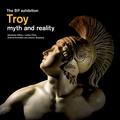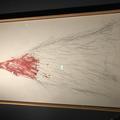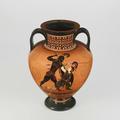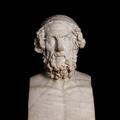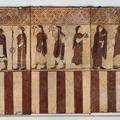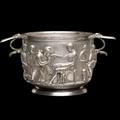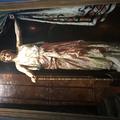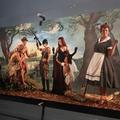Troy: Myth and Reality
The British Museum
The British Museum held the first major exhibition in Britain on Troy from Nov 21, 2019 to Mar 8, 2020. The Ertegun scholars had the chance to visit it on Sunday, February 16th. We were lucky to have listened to Dr Andrew Shapland explain the exhibition to us at the Ertegun House two days before, which gave us a deep insight into this grand project. The exhibition presents objects mostly from the British Museum’s own collection and also has loans from the Ashmolean Museum, the National Museum of Denmark and c. 100 loans from Berlin.
Upon entering the exhibition, we were struck by a modern painting by Ch Twombly made with oil, chalk and graphite in 1962. It represents Achilles’ vengeance over Hector’s killing of Patroclus. This striking painting gave us a hint as to what to expect in the exhibition – that is, not to expect to see artefacts from Troy but to hear its resonance throughout history. Right beside this painting, in a small cabinet, stood maybe one of the most interesting and yet humble pieces of the exhibition – a bronze age tripod vessel of 2550-2300 BC, that has suffered damages of war several times, including the bombing in Berlin during the Second World War, when it was badly burnt; a clear proof that the life story of archaeological artefacts continues even after they are excavated and even displayed. Their story is not frozen at some point in history; instead they continue in the present day and will continue in the future. Beside this humble grey pot stood in contrast a brilliant work of ancient art – an amphora depicting the moment of Achilles killing the Amazon queen Penthesilea and falling in love with her beauty the instant their eyes met as she was dying; one of the most tragic moments of the war, painted by Exekias around 530 BC.
As we turned the corner, a beautiful marble portrait bust of Homer, an artefact from the British Museum itself welcomed us into the “warzone” followed by some other artefacts showing how Homer was revered throughout history, including a fragment of a piece of papyrus with a pupil’s handwriting of Homer’s poem, found in an ancient gymnasium – obviously written while practicing and maybe memorizing the epic.
This main hall was divided into sections: discord (ἔρις), war (πόλεμος), fall (ἄλωσις), return (νόστος), each of them housing renowned artefacts mainly from the British Museum, but also from elsewhere, depicting certain moments from the ignition of the war (the judgement of Paris) to the return of the heroes. It was interesting to see a large terracotta panel from the Etruscan culture, dating to the sixth century BC and depicting the judgement of Paris and an intact embossed silver cup depicting King Priam kissing Achilles’ hand while asking for his son Hector’s body.
As we followed the story of the Trojan War through the eyes of ancient artists depicting scenes from the war on tiny gems, huge marble sarcophagi and breathtakingly shiny Athenian pottery we reached another section of the exhibition which told the story of the discovery of Troy. We were able to see William Gell’s drawings. Gell had looked for the site in the early 1800s but had missed it by a fraction. The next section showed original notebooks, drawings, photographs and first finds from Calvert and Schliemann’s excavations in the 1870s and 1890s. After learning about Schliemann’s excavation experiences, we dove into a new corner exhibiting objects which shed light on the complicated timeline of Troy – an artificial mound made of settlement upon settlement inhabited uninterruptedly for c. 4300 years, from c. 3000 BC until c. 1300 AD.
As we turned the corner, we were welcomed into a completely different part of the exhibition which presented a modern outlook of the subject. This section housed a video extract from the Queens of Syria re-enacting Euripides’ Trojan Women, graphic books, Hollywood film posters and modern paintings and prints covering subjects from the Trojan War such as journeys, heroes and women of the Trojan War. Two of the most striking of the paintings for me were Clytemnestra by John Collier (1882) and Elizabeth I and the Three Goddesses by Hans Eworth (1569).
Another very striking modern interpretation is by Eleanor Antin’s Judgement of Paris after a Rubens painting, giving the scene a humorous twist. Before completing this journey, we saw replicas of the so-called Helen’s Jewels accompanied by a famous photograph of Schliemann’s wife Sophia wearing them. The wave goodbye was by a light installation created by Spencer Finch in 2019 representing The Shield of Achilles.
It was interesting to see the story of the Trojan War through the eyes of both ancient and modern artists, to experience how it continues to influence our culture, almost 3300 years on.
Link to the exhibition website
BACKGROUND TO THE STORY
The Trojan War and the Iliad
One of the most read, retold and influential stories of history, the Iliad and its somewhat sequel Odyssey tell snippets of the Trojan War and its aftermath. The Iliad covers only a couple of weeks of the final year of the 10-year war while the Odyssey tells the story of Odysseus, a Greek hero trying to return home after the fall of Troy with several flashbacks to the war itself. Both are epic poems attributed to Homer, a blind bard of possibly the eighth century BC, born and bred on the Eastern Aegean coast, south of Troy, though there is no proof that he really existed. There are countless other sources – texts and works of art – that help us build up the full story of the Trojan War which is believed to have taken place sometime around 1280 BC, a rather chaotic period for the Aegean world.
According to the Epic Cycle, which is a collection of Ancient Greek epic poems, the whole story started out of envy during the divine wedding of Thetis and Peleus, a nymph and an elderly king. All the gods were invited except Eris, the goddess of discord, who sent in a wedding gift – a golden apple that read ‘to the fairest’ which was claimed by Athena, Aphrodite and Hera, followed by an unresolved quarrel between them. In order to stop the quarrel, Zeus fetched Paris, a young shepherd from Mount Ida, who was actually a Trojan prince who had been sent there by his father after hearing of a prophecy that he would bring downfall to Troy. The three goddesses separately bribed Paris into choosing them: Athena offered wisdom and the skill of great warriors, Hera offered political power and control over all of Asia, and finally Aphrodite offered him the love of the most beautiful woman in the world – Helen of Sparta, wife of King Menelaus. Paris decided to give the golden apple to Aphrodite who arranged for him to go back to his city and be re-accepted by his royal family after which he was sent to Sparta on a diplomatic mission with the underlying aim of bringing Helen to Troy. (The reason behind Aphrodite’s choice of Helen was that Menelaus, Helen’s husband, had promised to sacrifice 100 oxen to her, but he had forgotten and thus had invited Aphrodite’s vengeance.)
Some years after Helen’s abduction King Menelaus and his brother Agamemnon, King of Mycenae, gathered a fleet in which there were several renowned heroes, including quasi-immortal Achilles, son of Thetis and Peleus, and the cunning Odysseus, King of Ithaca. The second book of the Iliad, among several other sources, gives a detailed catalogue of the fleets, their numbers, commanders and origins (possibly from an original Bronze Age list). The same book also includes a list of Troy’s allies. Troy, throughout the war, was never completely besieged until the end and thus it maintained its contact with Asia Minor from where it received constant support.
The initial nine years of the war are not very well recorded or did not survive to our day. Most sources give accounts on mainly the last year of the war. The Iliad for instance begins at a point when King Agamemnon behaves disrespectfully to a priest of Apollo (Chryses) who was asking for his daughter back. This attitude brought on Apollo’s anger who then afflicted the Achaean army with plague. Agamemnon returned Chryseis, daughter of Chryses and instead took Achilles’ concubine Briseis. Angered Achilles managed to involve Zeus through his mother Thetis – Zeus decided that the Trojans would succeed as long as Achilles was absent. The gods were very much involved in the war, some supporting the Trojan side and others supporting the Achaeans – somewhat an indication of the mythological origins of each of these gods. Aphrodite, Ares, Apollo, Artemis, Eris, Leto, Zeus usually siding with the Trojans and Athena, Hera, Poseidon, Hermes, Hephaistus and Thetis siding with the Achaeans; with Hades, Dionysus, Hestia and Demeter taking a more neutral position. Some days after Achilles’ withdrawal, Zeus helped the Trojans break into the Achaean camp. Achilles’ best friend and relative Patroclus then wore Achilles’ armour and drove the Trojans back out of the camp all the way back to the city walls. He was only stopped by Apollo sending in a storm to protect the city. Patroclus was then killed by Hector, son of Trojan King Priam. This enraged Achilles who swore to kill Hector in revenge. Achilles then received Briseis back from Agamemnon and returned to the battle- field with new weapons forged by Hephaistus. Having been tricked by Athena, Hector remained outside the city walls, and was thus killed by Achilles who then tied the body onto his chariot and drove it around the plain – the worst display of disrespect. Apollo and Artemis however protected the body and maintained it unscathed. Following this event, the Achaeans held funerary games for Patroclus. Priam was then led by Hermes into Achilles’ tent to ask for the return of his son’s body. The Iliad, which accounts for only a couple of weeks, ends during the temporary truce between the two armies, during which Hector’s funeral is held.
Shortly after Hector’s funeral, Penthesilea, the queen of the Amazons arrived to help the Trojans but was killed by Achilles who fell in love with her beauty instantly upon killing her. After several other attacks, Achilles charged into Troy slaying everyone in his way. The gods decided that he had killed too many Trojan children, condemning him to death. Achilles was thus killed by Paris with an arrow to the back of his heel - the only part of his body that hadn’t touched the water of the River Styx when his mother dipped him in as a baby. A big fight broke out around Achilles’ body. Ajax fought off the Trojans while Odysseus brought Achilles’ body back to the camp. Achilles’ armour was offered to the smartest of the two heroes who saved the body, which created rivalry. Finally, the armour was awarded to Odysseus which drove Ajax mad with grief, leading him to want to kill all his comrades. With Athena’s intervention Ajax killed two rams instead of Agamemnon and Menelaus. When he woke up the next morning and realized what he had done he went mad again and committed suicide jumping onto his own sword.
The fall of the city was brought about by a cunning plan created by Odysseus – The Trojan Horse. This was a large hollow horse guided by Athena, led by Odysseus himself, filled with soldiers and inscribed with an inscription that read: “The Greeks dedicate this thank-offering to Athena for their return home”. The Achaean army left the horse behind, burned their camp and sailed off. Both Cassandra and Laokoön warned the Trojans against the horse, both of which were withheld by the gods. At midnight, the Trojans had been celebrating and were in a drunken state when the soldiers from inside the horse came out and killed the guards after which the fleets returned, entered through the gates and slayed the sleeping Trojans. Revolting massacres (Priam by Neoptolemus, Deiphobus by Menelaus, Astyanax), sacrifices (Polyxena by Neoptolemus) and rapes (Cassandra by Ajax the Lesser) took place in the city.
Although Troy fell, the story continues with the heroes trying to get back home or flee to their next destination. The most famous of the first being Odysseus and that of the latter being Aeneas, both fully engraved with myths. The Greeks themselves highly respected Homer but realized that, although the war was probably a historic fact, the poem had exaggerated the individual events. In modern times though, until Heinrich Schliemann started excavating in Hisarlık and Mycenae, the Trojan War had come to be regarded as a mythical story and Troy as a mythical place.
There seems to be historical truth in the Trojan War. The geological research carried out in Troy shows that the landscape in c. 1280 BC fits in perfectly with the descriptions of Homer and other authors of the epic cycle. Hittite texts also confirm a war at this time (a Tawagalawa letter is addressed to the king of Ahhiyawa on the other side of the sea that controls Millewanda – Miletus and mentions a certain Assuwa confederation which includes Wilusa – Ilium/Troy, it says that now an agreement can be made about Wilusa over which a war is fought; The Alexandu treaty also fits in with Paris’ name in the Iliad being Alexander). Under the Hittite King Tudhaliya IV (1240-1210) the Assuwa confederation was invaded but under Arnuwanda III (1210-1205) the Hittites had to abandon the Aegean coast. During this period of conflict Greek colonies were founded on the Eastern coast of the Aegean sea. The Trojan War has since become one of the most popular stories of history. Today it continues to influence all aspects of life.
The Discovery of Troy
Troy is located in northwestern Asia Minor, modern day Turkey, near a village called Hisarlık, at the southern tip of the Dardanelles, the last safe harbour for those heading north into the windy strait. It is an archaeological site inhabited for c. 4300 years, from c. 3000 BC until c. 1300 AD, forming an artificial mound (höyük in Turkish) of settlements built on top of one another. This mound was first identified by Charles Maclaren in 1822, studied and surveyed by Frank Calvert, whose family had bought that piece of land, but was never excavated until 1871 when Heinrich Schliemann, a rich German tradesman came into the picture. Calvert and Schliemann formed a partnership for a very short time until 1872, when they fell out due to what seems to be Schliemann’s techniques of archaeological excavations. Schliemann, believing that Priam’s Troy – the layers holding the remains of the Trojan War – should be at the deepest level, decided to dig a huge trench – the ‘Schliemann Trench’ – disrupting all the later upper levels of that section of the mound. Schliemann found large amounts of metal-ware and gold diadems which he later announced to be Priam’s Treasure (after smuggling them out of the Ottoman Empire). However, they were not; they pre-dated Priam by c. 1300 years and belonged to the Bronze Age, though they are still known popularly as Priam’s Treasure. They were housed in the Pergamon Museum in Berlin until the Second World War, during which they disappeared and reappeared in 1993 in Russia. Today they are housed in the Pushkin Museum in Moscow and the State Hermitage Museum in St. Petersburg.
Troy has been excavated ever since with some interruptions. Modern excavations began in 1988 and were carried out by Manfred O. Korfmann until his death in 2005. Tübingen University continued to excavate the site until 2013 when Çanakkale 18 Mart University took on this grand responsibility under the directorship of Prof Rüstem Aslan.
Serra Somersan


